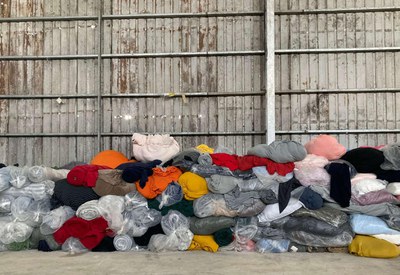Why recycling textile waste can be a key to circular economy
The Cambodian garment industry is the ninth largest garment producer in the world and being cited by the World Bank as “one of the fastest growing economies in the world”. It is therefore not surprising that the Cambodian garment industry also generates a vast volume of textile waste, primarily scraps left over after cutting, but also large cut lengths and end rolls of fabric. Data from Cambodia’s Ministry of Environment indicates that 60% of all industrial waste going to landfills comes from the garment industry, equivalent to about 90,000 tons in 2019.
The country's rapid population growth and industrialization have led to significant waste management challenges. Officially, textile waste generated from manufacturing in the Cambodian garment industry is disposed of in landfills by licensed disposal companies. However, there is also a thriving unregistered industry selling waste. In addition to disposal in landfills, cutting scraps are burned in factories and brick making sites, exported, and in very few cases recycled.
Factories often evade legal responsibilities of industrial recycling
Although a clear directive to support the establishment of industrial recycling facilities for the environment and for the economy has been voiced by several private and public stakeholders and the Cambodian government, there are still enough incentives for factories to sell textile waste through informal channels.
While it is the responsibility of the waste producer to dispose industrial waste legally and safely, in practice factories often evade this legal responsibility by selling to generate unregistered revenue. Often, they also see tax implications as the main barrier to formally selling their waste to recycling facilities.
Moving away from current deep-rooted practices requires a balance of education, brand influence as well as the development and implementation of government policies, and financial incentives. However, the establishment of a recycling facility for industrial textile waste, is a first step toward applying circular practices in the Cambodian garment industry. An industry that has faced financial challenges impacting its effective competitiveness for well over a decade, where rising labour costs have not occurred simultaneously with a rise in productivity or efficiency. As other manufacturing regions invest in vertical systems, Cambodia is being left behind.
What is the report "Waste Streams Mapping" about?
The report "Waste Streams Mapping – Pathways from Key Suppliers to Landfill" which was commissioned by the GIZ project FABRIC (Fostering and Advancing Sustainable Business and Responsible Industrial Practices in the Clothing Industry in Asia), aims to map the waste stream from factory through to landfill (or burning). In addition, the project intends to provide an overview of the stakeholders, the consumption and the purpose of usage across the various waste pathway streams. The gained insights will contribute to a broader feasibility study determining if there is demand for domestic industrial textile recycling.
The report provides insights into the Cambodian garment manufacturing industry and waste management sector. It includes an in-depth analysis resulting from the collected data from the interviews and surveys with factories and waste collectors. Topics evaluated in the analysis include “waste measurement and management practices” and “environmental awareness and sustainability practices” in the Cambodian textile industry. In addition, the report also highlights the role of the informal sector. It describes the consequences of selling textile waste to informal sector actors and what challenges the various stakeholders need to face in order to develop economically and environmentally.
What does the introduction of circular principles bring to the current sector? Can the establishment of a recycling facility pave the way for vertical practices? What opportunities and challenges arise from the implementation of circular principles? And what incentives do these actions offer to attract brands and potentially new investors? Find in-depth answers to these questions and more in the latest report "Waste Streams Mapping – Pathways from Key Suppliers to Landfill.”

